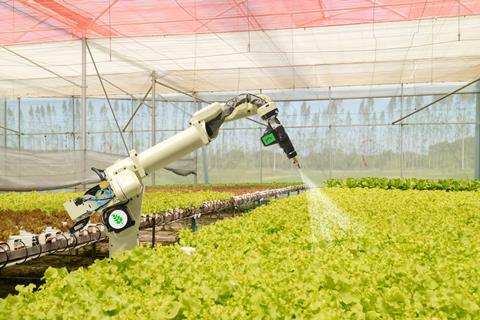GlobalData report says the robotics industry will hit US$218bn in 2030, helping the agricultural sector tackle climate change and labour shortages
Data and analytics group GlobalData has predicted that the robotics industry is set to grow at a compound annual growth rate (CAGR) of 17 per cent to 2030, from US$63bn in 2022 to US$218bn.

GlobalData’s latest Thematic Intelligence report, ’Robotics in Agriculture’, revealed how robotics is helping to achieve precision agriculture and support workers in what it called ”a new agricultural revolution”.
It pointed out that the global agriculture sector faced various challenges, including the impact of climate change and labour shortages.
Robotics could help agriculture companies tackle these challenges by automating machines and supporting vertical farming, GlobalData noted.
“Robots can carry out the strenuous and monotonous tasks that lead to injuries and fatigue,” said Holly Anness-Bradshaw, associate thematic intelligence analyst at GlobalData.
”The agriculture industry is investing and innovating in many parts of the robotics industry, including drones, field robots, and robotics intelligence,” she outlined. ”Robots can be found on vineyards, with Burro’s robots helping workers carry up to 500 pounds of crops around fields and back to sorting houses.”
The future of agriculture will be underpinned by robots that augment the industry’s workforce, GlobalData predicted, with robots assisting workers in the agriculture sector, not replacing them.
“Traditional agricultural companies like John Deere and Cargill, as well as agricultural startups, are all hiring and innovating in robotics,” Anness-Bradshaw continued. ”The agricultural sector is becoming increasingly aware of the potential and need for robotics to support labour and increase agricultural productivity.
”Companies are forming partnerships with startups, like that between John Deere and Blue River Technologies, which led to the launch of the See & Spray.
”The See & Spray is a robot that uses sensors and AI to target weeds and spray pesticides precisely,” she explained. ”Robots will support human workers by automating repetitive and strenuous tasks, such as tilling, but will also learn crop health and growing patterns.”
Robots are learning the growing patterns of specific produce, GlobalData confirmed, and with the integration of artificial intelligence (AI) with agricultural robots, this data will be used to improve farm management strategies.
“Companies like Dogtooth are aiming to fully automate the lifecycle of strawberries to alleviate the pressure of labour shortages that lead to excess food waste so crops do not go unpicked,” Anness-Bradshaw added.
”Dogtooth is a strawberry-picking robot arm, which is integrated with sensors, cameras, and AI. The robot can navigate rows of strawberries, determine whether they are ripe, delicately pick the berries, and then package them into punnets.”



